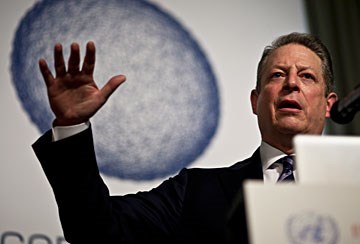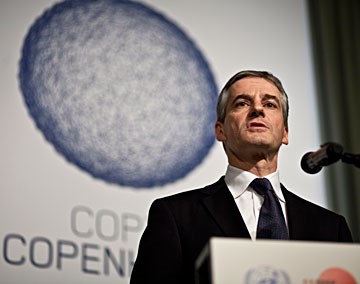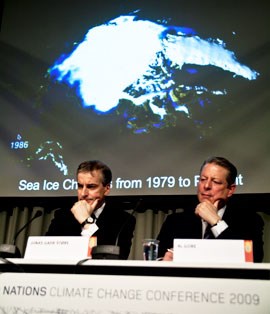Støre og Al Gore presenterer rapport om issmelting på klimatoppmøtet
Historisk arkiv
Publisert under: Regjeringen Stoltenberg II
Utgiver: Utenriksdepartementet
Pressemelding | Dato: 14.12.2009
For første gang har ledende internasjonale forskere laget en oversikt over snø- og issmelting globalt. Konklusjonene viser at snø- og isdekte områder forsvinner raskere enn tidligere antatt. – Dette er skremmende nyheter, sier utenriksminister Jonas Gahr Støre.
For første gang har ledende internasjonale forskere laget en oversikt over snø- og issmelting globalt. Konklusjonene viser at snø- og isdekte områder forsvinner raskere enn tidligere antatt. – Dette er skremmende nyheter. Verdens ledere må nå komme fram til en løsning som sikrer dramatiske kutt i utslipp av klimagasser, sier utenriksminister Jonas Gahr Støre.
 I dag legger utenriksminister Støre og USAs tidligere visepresident Al Gore frem en rapport om global snø- og issmelting under en side-event på klimatoppmøtet (COP15) i København. Støre og Gore tok initiativ til rapporten under Melting Ice-konferansen i Tromsø i april. En vitenskapelig arbeidsgruppe, som har involvert en rekke av verdens ledende forskere, fikk i oppgave å utarbeide en rapport om issmelting til FNs klimakonferanse. Norsk Polarinstitutt har koordinert arbeidet.
I dag legger utenriksminister Støre og USAs tidligere visepresident Al Gore frem en rapport om global snø- og issmelting under en side-event på klimatoppmøtet (COP15) i København. Støre og Gore tok initiativ til rapporten under Melting Ice-konferansen i Tromsø i april. En vitenskapelig arbeidsgruppe, som har involvert en rekke av verdens ledende forskere, fikk i oppgave å utarbeide en rapport om issmelting til FNs klimakonferanse. Norsk Polarinstitutt har koordinert arbeidet.
Rapporten viser at nedsmeltingen skjer i et alarmerende tempo og snø - og isdekte områder er svært sårbare overfor klimaendringer. Det viktigste, og nye, er knyttet til Antarktis. Det mektige Antarktis, som hittil har virket immunt mot reduksjon av is som har rammet andre områder, viser nå tegn på netto reduksjon av ismasse på nivå med reduksjonen av innlandsisen på Grønland.
 - Dette er bekymringsfullt. Det overordnede budskapet er at vi må lykkes i København. Verdens land må bli enige om tiltak som begrenser klimautslippene og reduserer oppvarmingen til to grader. Videre trenger vi en beredskapsplan for de is- og snødekte områdene som inneholder øyeblikkelige tiltak for å bevare så mye av det globale is- og snødekket som overhodet mulig. Vi må begynne med å kutte utslippene av kortlivede klimadrivere, for eksempel sot og ozon, som i dag ikke dekkes av noen klimaavtale, og få et sterkere fokus på kortlivede klimagasser som HFK og metan. Tiltak her vil gi umiddelbar effekt og koster lite, sier utenriksminister Støre.
- Dette er bekymringsfullt. Det overordnede budskapet er at vi må lykkes i København. Verdens land må bli enige om tiltak som begrenser klimautslippene og reduserer oppvarmingen til to grader. Videre trenger vi en beredskapsplan for de is- og snødekte områdene som inneholder øyeblikkelige tiltak for å bevare så mye av det globale is- og snødekket som overhodet mulig. Vi må begynne med å kutte utslippene av kortlivede klimadrivere, for eksempel sot og ozon, som i dag ikke dekkes av noen klimaavtale, og få et sterkere fokus på kortlivede klimagasser som HFK og metan. Tiltak her vil gi umiddelbar effekt og koster lite, sier utenriksminister Støre.
- Denne rapporten er resultatet av over to års arbeid sammen med utenriksminister Jonas Gahr Støre og mange av verdens ledende forskere. Den viser at vi må handle umiddelbart hvis vi skal finne en løsning på klimakrisen. Økosystemet i Arktis, verdens isbreer – ja, hele kryosfæren står i fare for å bli ødelagt hvis vi ikke kutter i utslippene som fører til global oppvarming, sier Al Gore.
Rapporten viser for øvrig blant annet at:
- Nedsmeltingen av iskappen på Grønland er tredoblet bare de ti siste årene.
- Snødekket minker, og isbreer fra Himalaya til Alpene smelter raskt, med størst nedsmelting i Andesfjellene og Rocky Mountains.
- De forrige tallene fra FNs klimapanel, som kom i 2007, antydet at havet ville stige med nesten en halv meter innen 2100, men dette anses nå som et minimumsanslag. Siden nedsmeltingen både på Grønland og andre steder går raskere enn ventet, er anslaget nå mellom 0,5 og 1,5 meter innen 2100. Dette vil ramme mange hundre millioner mennesker som bor i kystnære områder.
- Når snø og havis smelter, reflekteres det mindre sollys fra jordens overflate, og når permafrosten tiner, frigjøres det mer metan og CO2 enn forventet. Begge disse endringene fører til raskere oppvarming av kloden og dermed forsterket issmelting.
- Nedsmelting av isbreer kan føre til utstrakt vannmangel. I dag er over en milliard mennesker avhengige av vann bare fra Himalaya-platået, som gjerne omtales som «den tredje pol».

Les rapporten på: www.regjeringen.no/callforaction
For fagspørsmål, kontakt Norsk Polarinstitutt ved direktør Jan-Gunnar Winther.